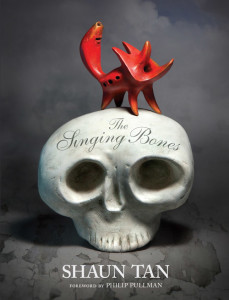Allen & Unwin Children
September 2015
 The release of a new book by Shaun Tan should be accompanied by a day of national celebration. If the state of Victoria can celebrate a horse race, then it’s not too much to ask that the country as a whole take a day to wave a coloured flag for artistry and wonder. Parades would be necessary, full of papier-mâché creatures. Confetti of reds and oranges and yellows would rain from the skies as if Autumn had come all at once. There would be songs with no words, and random kindnesses between strangers. And at the end of the day, we’d sit around a giant fire and watch as stories unfolded in the shadow of the flames.
The release of a new book by Shaun Tan should be accompanied by a day of national celebration. If the state of Victoria can celebrate a horse race, then it’s not too much to ask that the country as a whole take a day to wave a coloured flag for artistry and wonder. Parades would be necessary, full of papier-mâché creatures. Confetti of reds and oranges and yellows would rain from the skies as if Autumn had come all at once. There would be songs with no words, and random kindnesses between strangers. And at the end of the day, we’d sit around a giant fire and watch as stories unfolded in the shadow of the flames.
Shaun Tan can craft a story in a way that you didn’t know you needed until the manifest form of it was resting in your hand, a tangible thing that seemed to emerge straight out of the ether of endless myth rather than shaped by mortal hands. His stories are small stories (The Red Tree, The Lost Thing), and yet they speak directly to the core of human loneliness and connection. We are individuals standing in a world that is both beautiful and menacing, a shared space and yet so full of distance and emptiness. If you’ve ever felt lost in the world, chances are that Shaun Tan could help you see that being lost is something we all share, and actually there’s radiance in not knowing where you’re going.
Before The Singing Bones existed, there was a hole in the world we didn’t even know was there. Many artists have illustrated the fairy tales of the Brothers Grimm, and yet, as Philip Pullman describes in his introduction, many of them over embellished, they gave away too much, or, as Jack Zipes laments, they smoothed over the glorious grotesqueries and left behind a half thing, hobbled and toothless, that wouldn’t offend anyone. The Singing Bones gifts us with a simplicity and horror that rises straight from the dark pit of the subconscious, raw and emotional.
Tan has set aside his usual illustrated format and instead handcrafted figurines in clay. These sculptures, the embodiment of each story, are at once both lifeless objects and living things; it’s as if, as characters, they were living out their stories until someone yelled, “Freeze!” and now they’re stuck, waiting for their chance to start where they stopped. The four animals of The Brenen Town Musicians, donkey, dog, cat and rooster, are stuck making their music, their snouts and beaks frozen in disfigurement, until time unfreezes again and their noise can frighten the robbers away. In Simelei Mountain, we see a single figure climbing into a mountain cave glowing gold. Is the figure the poor man or his greedy brother, who will later have his head cut off? Only the restart of time will reveal. We see nothing of the whole, only of the moment, and yet we are swept away. We lean forward; ready to take a step when time moves again. What power is this that can bring life to lifeless things?
Each sculpture in The Singing Bones captures an unspeakable yearning. It’s like looking back to a time in the history of civilisation when we lacked the words to describe our own experience. So instead we carved figures in rock, wood and clay to act as totems for our emotions, and we gave these figures lives of their own. Tan has tapped into that primitive wordlessness. It’s a rare vision that can convey the guttural brutality of survival with fairy tale whimsy while using the barest of words.
Rather than following a path well-travelled, Tan has chosen a new medium and a new visual voice. There’s the same focus on detail always seen in Tan’s work, but also a necessary rawness that comes with modeling clay with fingers. That rawness perfectly suits the macabre nature of Grimm’s fairy tales, which are full of injustices, betrayals, and, occasionally, triumphant love. It’s hard to imagine a better tribute to the community of minds that shaped these stories over generations.


I think Louise encapsulates it in “… chances are that Shaun Tan could help you see that being lost is something we all share…”
But while being lost is dramatic and traumatic, the point of folk tales and myth is to help us find our way back home.